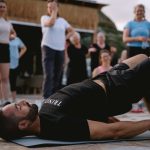Learning how to build muscle over 40 can feel confusing and frustrating, especially when the strategies that worked in your 20s and 30s no longer deliver results.
Maybe you’ve been doing spin classes or HIIT workouts, sweating buckets every week, but the scales haven’t moved. Maybe your clothes feel tighter even though you’ve “done everything right” like eating less, cutting carbs, or even considering quick-fix weight loss jabs.
Or maybe you’ve noticed your body just doesn’t feel like your own anymore and your energy’s dipped, your joints ache, and you don’t feel comfortable in your favourite outfits.
If this sounds familiar, you’re not failing, your body is just changing. What worked in your 20s and 30s often doesn’t work after 40, because hormones shift, metabolism slows, and muscle becomes harder to build.
But with the right strategy, you can not only build muscle but also feel stronger, fitter, and more confident than ever.
In this article, we’ll explain why it’s harder to build muscle after 40, how to do it successfully, the mistakes to avoid, and the exact steps our clients use to see results that last.

Why It’s Harder to Build Muscle After 40
One of the biggest frustrations we hear from women in midlife is that they’re working harder than ever but seeing fewer results. So, why does this happen?
Hormonal Changes Shift How Your Body Responds
From perimenopause onwards, levels of estrogen and progesterone begin to decline. These hormones play a role in regulating cortisol (your stress hormone), insulin (your blood sugar hormone), and muscle maintenance.
As they shift, your body becomes more sensitive to stress, less efficient at burning fat, and quicker to lose muscle unless you actively work to preserve it.
Cortisol Gets in the Way
High-intensity cardio spikes cortisol levels. In small amounts, cortisol isn’t a problem as it’s part of your body’s natural stress response. But when cortisol stays high, it makes weight loss harder by slowing your metabolism, driving cravings, and encouraging fat storage around the middle.
This is why hours of cardio often backfire for women over 40.
Muscle Naturally Declines With Age
From around 40, muscle mass begins to decline each decade unless you do something to prevent it. Less muscle means a slower metabolism, less tone, weaker bones, and joints that ache more easily.
This is why women often describe feeling “softer” or “flabbier” even if the scale hasn’t changed much.
Cardio Can Be Hard on Your Joints
Running, HIIT, and other high-impact workouts may feel effective, but they put enormous stress on knees, hips, and backs, especially if you’re carrying extra weight.
Many women in our Fit Over 40 program came to us with sore joints from years of punishing workouts, only to discover there’s a safer and more effective way forward.

“Until I came across Trinity I had started to believe it was age and menopause related and there was no escaping – especially when I looked around and saw my female peers similarly changing shape round the middle. I figured I would just have to get used to it. I took up cycling 3x a week for 40 mins to get me “fit” and out of the house. I was really disappointed that it made zero impact on my physique or weight. Since Trinity I’ve lost 1 stone in the first 12 weeks.The program has taught me to I can TAKE CARE OF ME and by doing that I can take care of my loved ones.”
– Jo McClements (56), Trinity Client
5 Ways to Build Muscle For Women Over 40
1. Prioritize Strength Training
After 40, muscle mass naturally declines, and without intervention, this loss accelerates during menopause. Less muscle means a slower metabolism, lower strength, and a greater risk of falls and injury as you age.
Strength training gives your body the direct signal it needs to hold onto and build new muscle, counteracting this decline.
This doesn’t mean you need to spend hours lifting heavy barbells in the gym. Even two to three structured strength workouts a week can make a profound difference.
- Start with 2–4 full-body strength sessions per week.
- Focus on big, compound exercises like squats, deadlifts, push-ups, and rows.
- Use weights heavy enough that the last 2–3 reps of a set feel challenging but still safe.
- Progress gradually by adding weight, reps, or sets over time.

2. Eat Enough Protein
Many women over 40 eat far less protein than their bodies actually need. Without enough protein, your muscles simply cannot repair and grow after exercise, no matter how much strength training you do.
Protein also helps regulate appetite, keeps blood sugar steady, and supports bone and skin health which are all areas that become more important in menopause.
Think of protein as the building blocks of your muscles. When you strength train, you create tiny tears in your muscle fibres, and protein is what allows them to rebuild stronger than before.
Without enough, you’re doing the work without getting the reward. Aim for 1.2–1.6 grams of protein per kg of body weight per day. For a 70kg woman, that’s around 85–110g daily.
Try to spread protein across all meals to maximize absorption and include high-quality sources like lean meat, poultry, fish, eggs, Greek yogurt, tofu, beans, and protein powders.
3. Balance Hormones and Manage Cortisol
Menopause causes shifts in estrogen, progesterone, and testosterone, which all play a role in muscle growth. On top of this, chronic stress can keep cortisol levels high, making it harder to recover, build muscle, and lose fat.
There are a few ways you can do this:
- Prioritize quality sleep (7–9 hours).
- Reduce reliance on high-intensity cardio.
- Include relaxation practices like deep breathing, yoga, or walking outdoors.
- Focus on blood sugar balance by eating protein, healthy fats, and fibre with each meal.
4. Support Recovery
At 40+, recovery takes longer. Skipping rest or overtraining leads to injury, burnout, and plateaus. Muscles don’t grow in the gym, they do however grow when you rest.
Try to take at least 1-2 rest days per week, you can use these days to add mobility work like stretching, yoga or foam rolling. Also ensure you stay hydrated as this will help support muscle repair and joint health.
5. Train Smarter, Not Harder
Endless high-rep toning classes or hours on the treadmill aren’t the key to building lean muscle. For women over 40, a structured, progressive program that respects your body is far more effective.
Aim to keep workouts 30-60 minutes and stick to 6-8 key exercises per session instead of jumping between dozens. You should also track your progress so you’re consistently improving instead of repeating the same easy routine.

“Before I started Trinity I was pretty fed up with the way I felt in relation to my body – my weight had gradually crept up to nearly 80kg. I felt I was relatively fit- an active member of 2 gyms doing regular classes like body attack, body pump, HITT step, balance, yoga/ Pilates. Sleep quality was poor, things would be going through my head from the day, and I would struggle to drop off to sleep. In just over a year with Trinity, weight wise I have lost 13kg. I enjoy my LIST workouts, it’s part of my routine, I canceled a gym membership. My strength is improved. My mind-set has totally changed. I feel much happier, and satisfied with life.”
– Helen Huntington (57), Trinity Client
What to Avoid in Menopause if You Want to Build Muscle
1. Crash Dieting
One of the most common mistakes women make in midlife is dramatically cutting calories. While this might seem like the fastest way to drop weight, your body sees it as a stressor.
In response, it raises cortisol, your stress hormone, which promotes fat storage around the middle and makes it harder to build lean tissue. Worse still, when you’re not eating enough, your body starts breaking down muscle for fuel.
Since muscle is what keeps your metabolism higher, you end up burning fewer calories over time, which is the opposite of what you want. In menopause, when metabolism naturally slows, crash dieting accelerates muscle loss and makes long-term weight management nearly impossible.
2. Relying Only on Cardio
Cardio can play a role in overall health, but when it’s your only form of exercise, it sets you up for frustration. Cardio burns calories while you’re doing it, but it doesn’t tell your body to hold on to or build new muscle.
That means your metabolism doesn’t get the lasting boost that comes with strength training. For women over 40, too much cardio can also aggravate joint issues and raise cortisol, making fat loss even harder.
A balanced plan that includes both cardio for heart health and resistance training for muscle is far more effective than cardio alone.
3. Skipping Strength Training Because It Feels Intimidating
Many women avoid lifting weights because they’re worried it will make them “bulky.” In reality, female hormone levels make it extremely difficult to build bulky muscle.
What actually happens is that strength training helps sculpt lean, toned muscle while reducing fat which is what creates the strong, defined look so many women want.
In menopause, this becomes even more important because strength training protects bone density, improves balance, and supports hormone health.
Avoiding it out of fear or intimidation keeps you stuck in the same cycle of cardio and dieting that doesn’t deliver results.
4. Overtraining Without Recovery
It’s tempting to think that more exercise means faster progress, but this is another trap. After 40, your body needs more recovery time than it did in your 20s. Overtraining pushes your body into a stressed state.
High cortisol, sore joints, poor sleep, and constant fatigue are all signs of doing too much. And here’s the irony: muscles don’t grow during the workout, they grow during recovery. Without proper rest, you block the very progress you’re working so hard for.
5. Ignoring Nutrition
Simply eating “healthy” is not enough when you want to build muscle in menopause. Many women eat plenty of vegetables but skimp on protein, leaving their muscles without the raw materials they need to repair and grow.
Others cut out whole food groups like carbohydrates, which can leave you fatigued and unable to fuel effective workouts. Building muscle requires a balance: adequate protein to support repair, carbohydrates for energy, and healthy fats for hormone production.
Without this balance, your workouts will feel harder, recovery will be slower, and results will come much more slowly.
How Trinity Can Help You Too
At Trinity, we’ve helped over 7,000 women transform their bodies with our Fit Over 40 program. 97% of clients lose weight in the first 12 weeks, and they keep it off because this isn’t a quick fix.
We’re different from fad diets or weight loss drugs. Our program is a complete re-education, it’s a lifestyle shift that works with your hormones, protects your joints, and teaches you how to train, eat, and recover in a way that feels sustainable.
Our expert coaches guide you step by step, with personalised support and accountability.
Instead of guessing, you’ll know exactly what to do, and you’ll finally see the results you’ve been working so hard for: dropping dress sizes, feeling confident in your clothes, and enjoying weekends and holidays without worrying about keeping up.
If you’re ready to stop spinning your wheels and start building the strong, toned body you deserve, Trinity’s Fit Over 40 program is here to help.




